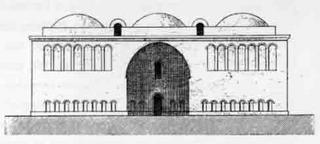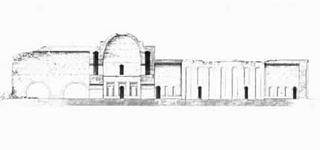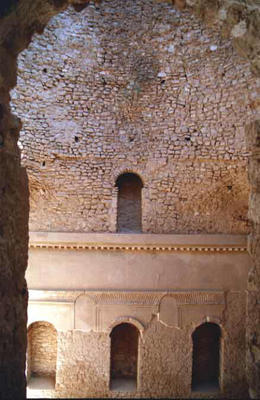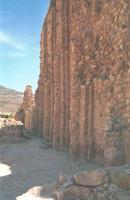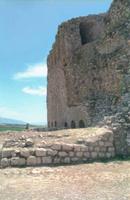Adobe buildings, particularly earthquake-proof ones have been a challenge of architects and engineers for a long time. Whatever these workshops and building experiences can offer to rebuilding Bam citadel, will have influences beyond the Bam project and can have many applications in different parts of Iran. --Siamak D. Ahi

French Institute Constructs
Adobe Building in Bam
CRAT Institute of France constructs a building with laboratory-made adobe in Bam city.
Tehran, 1 October 2005 (CHN) – CRAT, a French adobe architecture research institute, will build an adobe building to encourage this style of architecture in Bam. The adobes used in the building are examples of adamant clays produced in the laboratory in Bam Citadel.
The protection of adobe structures is a new field and that has faced experts of cultural heritage with some problems in dealing with this kind of architecture.
“Centre de recherche sur l'antiquité tardive” (CRAT, the research center for late antiquities), an institute of Université Stendhal Grenoble, is currently engaged in building an adobe structure to promote this style of architecture in the earthquake stricken city of Bam. Concrete is also used as a material for construction of the building,” says Eskandar Mokhtari, head of Bam Citadel salvation project.
“This project,” he added, “is an example of adobe structure with concrete horizontal and vertical foundation, but the main body of the building is made of adobe.
”CRAT is one of the institutes that became active in rehabilitation of the Citadel after the earthquake hit the area in 2003, bringing down the Citadel and living tens of thousands dead and homeless.
According to Mokhtari, “besides engaging in the construction of the building, Iranian experts will be educated for restoration of adobe structures. Three experts from Bam Salvation Project will also participate in the construction”.
The 2 thousand-year Bam Citadel is one of the biggest adobe complexes in the world, 60 percent of which was ruined by the earthquake of 2003. In the last year’s UNESCO Cultural Heritage Conference in China, Bam city and its historical, cultural landscape was registered on the World Cultural Heritage List. The Citadel Salvation Project is underway with financial and expertise aid from international organizations and bodies.
Bam Citadel to Host Workshop
A joint team of Iranian and Italian experts will hold a workshop in Bam Citadel for adobe preservation and restoration.
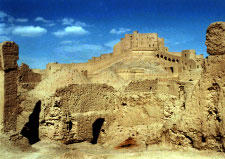 Tehran, 25 September 2005 (CHN) -- A team consisting of Italian and Iranian experts will hold training classes for preservation and restoration of adobe sites in Bam Citadel in February/March 2006.
Tehran, 25 September 2005 (CHN) -- A team consisting of Italian and Iranian experts will hold training classes for preservation and restoration of adobe sites in Bam Citadel in February/March 2006.Restoration and preservation of adobe structures is a new domain, therefore experts of the Cultural Heritage and Tourism Organization of Iran have faced many problems in this regard.
“Iranian and Italian experts will hold two training courses for preservation and restoration of adobe sites in Bam Citadel at the end of the coming winter,” said Eskandar Mokhtari, head of Bam Salvation Project.
Mokhtari explained that based on meetings held by the attendance of the Italian team during this week, the classes will be held for experts and craftsmen both in theory and practice.
By the time the classes are held, the restoration of one of the towers of Bam Citadel, its Tekieh (the place for holding religious ceremonies), and Sistani house is expected to be finished.
Mokhtari described these classes as a valuable opportunity for the trainees.
The earthen city of Bam is one for the most important historical and cultural cities in the world which dates back to 2000 years ago. The site was almost destroyed in the earthuake that hit the area in 2003. Bam and its cultural landscape were registered on World Heritage List of UNESCO in 2004.
Underground Cubbyholes
Surface in Bam Citadel
Two adjacent underground rooms now filled with debris have been discovered in Bam Citadel. Tehran, 7 September 2005 (CHN) -- Excavations in Bam Citadel led to the discovery of two underground cubbyholes in the barrack section of the Citadel.
Tehran, 7 September 2005 (CHN) -- Excavations in Bam Citadel led to the discovery of two underground cubbyholes in the barrack section of the Citadel.
According to experts, the historical Bam Citadel, which is one of the biggest earthen structures in the world and was registered on UNESCO World Heritage List dates back to the Sassanid era, but the exact time of it is not yet known.
“In excavations of the east side of the main gate of the barrack, we discovered two closed doors. After opening them, two small underground cubbyholes were discovered,” says Eskandar Mokhtari, head of Bam Salvation Project.
According to him, the rooms are connected to each other and due to the destruction of their roofs, they have been filled with soil and debris. The original body of the rooms had been made of adobe on which some brick reconstructions have been done.
One of the discovered rooms is 225x252 square centimeters and the other 323x252 square centimeters. Of the first room just some small parts are left intact. Due to the dampness, the adobe structure of the rooms has decayed. A shell and a piece of metal have been found in the room.
After the earthquake that hit Bam two years ago, the Cultural Heritage and Tourism Organization of Iran with the cooperation of some of the world organizations such as UNESCO have started some activities for the salvation of the historical sites of Bam city.
In the 29th session of UNESCO World Heritage committee which was held in Durban in South Africa, UNESCO praised the so-far attempts of Iranian officials and countries helping in the project including Japan and Italy.
The earthen city of Bam is one for the most important historical and cultural cities in the world which dates back to 2000 years ago. Last year in the UNESCO’s World Heritage Committee held in China, some decisions were made for Bam Salvation and Bam was registered in UNESCO World Heritage List.


